On-Demand Design of Terahertz Metasurface Sensors for Detecting Plant Endogenous and Exogenous Molecules
Abstract
1. Introduction
2. Methods and Materials
2.1. Target Terahertz Fingerprint Peak Acquisition
2.2. On-Demand Design Overall Concept
2.3. Dataset Construction for Inverse Design of Terahertz Metasurface Sensors
3. Results and Discussion
3.1. Fingerprint Peak Analysis of Gibberellic Acid and ABA Based on DFT
3.2. Comparison of On-Demand Design Algorithms
3.3. Verification and Evaluation of the Performance of the On-Demand Design Single Resonance Peak Sensors
3.4. Verification and Evaluation of the Performance of the On-Demand Design Dual Resonance Peak Sensors
4. Discussion
Supplementary Materials
Author Contributions
Funding
Institutional Review Board Statement
Data Availability Statement
Conflicts of Interest
Abbreviations
References
- Yan, K.; Bian, T.; He, W.; Han, G.; Lv, M.; Guo, M.; Lu, M. Root Abscisic Acid Contributes to Defending Photoinibition in Jerusalem Artichoke (Helianthus tuberosus L.) under Salt Stress. Int. J. Mol. Sci. 2018, 19, 3934. [Google Scholar] [CrossRef]
- Yuan, J.; Zhang, T.; Hu, Y.; Bai, L.; Zhang, L.; Yang, J.; Zheng, Y.; Qin, Y.; Xu, Z.; Han, T.; et al. Effects of Plant Growth Regulators and Endogenous Phytohormone Profiles on the Rooting of Tissue Culture Raised Shoots of Persimmon (Diospyros Kaki Thunb.). Sci. Hortic. 2025, 339, 113917. [Google Scholar] [CrossRef]
- Zhao, X.; Wu, Y.; Qian, J.; Bian, G.; Zhang, X.; Su, B.; Tian, Y.; Huang, D. Investigation of Endogenous Phytohormones and Critical Flowering Genes during Flower Development in Iris Germanica. Sci. Hortic. 2024, 336, 113401. [Google Scholar] [CrossRef]
- Kamboj, A.; Sangha, M.K.; Devi, V.; Kumar, P.; Pathak, M.; Singla, D. Enhancing Germination and Growth in Wild Okra Genotypes through Gibberellic Acid Priming. Sci. Hortic. 2024, 334, 113332. [Google Scholar] [CrossRef]
- Pan, W.; Cheng, X.; Du, R.; Zhu, X.; Guo, W. Detection of Chlorophyll Content Based on Optical Properties of Maize Leaves. Spectrochim. Acta Part A 2024, 309, 123843. [Google Scholar] [CrossRef]
- Sun, H.; Zhang, X.; Zuo, W.; Dai, Z.; Zhou, L.; Luo, F.; Yang, M.; Wang, X.; Lou, Z.; Chen, Z. Concentrations, Generation and Risk Characterization of Phthalimide in Tea-Derived from Folpet or Not? Sci. Total Environ. 2022, 852, 158194. [Google Scholar] [CrossRef]
- Luo, Z.; Zhang, L.; Mou, Y.; Cui, S.; Gu, Z.; Yu, J.; Ma, X. Multi-Residue Analysis of Plant Growth Regulators and Pesticides in Traditional Chinese Medicines by High-Performance Liquid Chromatography Coupled with Tandem Mass Spectrometry. Anal. Bioanal. Chem. 2019, 411, 2447–2460. [Google Scholar] [CrossRef]
- Chen, Y.; Wu, X.; Li, Y.; Yang, Y.; Yang, D.; Yin, S.; Liu, L.; Sun, C. Simultaneous Determination of Seven Plant Growth Regulators in Melons and Fruits by Modified QuEChERS Coupled with Capillary Electrophoresis. Food Anal. Methods 2018, 11, 2788–2798. [Google Scholar] [CrossRef]
- Lee, D.G.; Lee, J.; Kim, K.-T.; Lee, S.-W.; Kim, Y.-O.; Cho, I.-H.; Kim, H.-J.; Park, C.-G.; Lee, S. High-Performance Liquid Chromatography Analysis of Phytosterols in Panax Ginseng Root Grown under Different Conditions. J. Ginseng Res. 2018, 42, 16–20. [Google Scholar] [CrossRef]
- Yazici, A.; Tiryaki, G.Y.; Ayvaz, H. Determination of Pesticide Residual Levels in Strawberry (Fragaria) by near-Infrared Spectroscopy. J. Sci. Food Agric. 2020, 100, 1980–1989. [Google Scholar] [CrossRef]
- Fan, H.; Smuts, J.; Walsh, P.; Harrison, D.; Schug, K.A. Gas Chromatography–Vacuum Ultraviolet Spectroscopy for Multiclass Pesticide Identification. J. Chromatogr. A 2015, 1389, 120–127. [Google Scholar] [CrossRef] [PubMed]
- Guo, Z.; Wang, M.; Wu, J.; Tao, F.; Chen, Q.; Wang, Q.; Ouyang, Q.; Shi, J.; Zou, X. Quantitative Assessment of Zearalenone in Maize Using Multivariate Algorithms Coupled to Raman Spectroscopy. Food Chem. 2019, 286, 282–288. [Google Scholar] [CrossRef]
- Jiang, H.; He, Y.; Xu, W.; Chen, Q. Quantitative Detection of Acid Value during Edible Oil Storage by Raman Spectroscopy: Comparison of the Optimization Effects of BOSS and VCPA Algorithms on the Characteristic Raman Spectra of Edible Oils. Food Anal. Methods 2021, 14, 1826–1835. [Google Scholar] [CrossRef]
- Li, H.; Haruna, S.A.; Wang, Y.; Mehedi Hassan, M.; Geng, W.; Wu, X.; Zuo, M.; Ouyang, Q.; Chen, Q. Simultaneous Quantification of Deoxymyoglobin and Oxymyoglobin in Pork by Raman Spectroscopy Coupled with Multivariate Calibration. Food Chem. 2022, 372, 131146. [Google Scholar] [CrossRef]
- Sun, Y.; Tang, H.; Zou, X.; Meng, G.; Wu, N. Raman Spectroscopy for Food Quality Assurance and Safety Monitoring: A Review. Curr. Opin. Food Sci. 2022, 47, 100910. [Google Scholar] [CrossRef]
- Auner, G.W.; Koya, S.K.; Huang, C.; Broadbent, B.; Trexler, M.; Auner, Z.; Elias, A.; Mehne, K.C.; Brusatori, M.A. Applications of Raman Spectroscopy in Cancer Diagnosis. Cancer Metastasis Rev. 2018, 37, 691–717. [Google Scholar] [CrossRef]
- Fakhlaei, R.; Babadi, A.A.; Sun, C.; Ariffin, N.M.; Khatib, A.; Selamat, J.; Xiaobo, Z. Application, Challenges and Future Prospects of Recent Nondestructive Techniques Based on the Electromagnetic Spectrum in Food Quality and Safety. Food Chem. 2024, 441, 138402. [Google Scholar] [CrossRef] [PubMed]
- Mao, H.; Du, X.; Yan, Y.; Zhang, X.; Ma, G.; Wang, Y.; Liu, Y.; Wang, B.; Yang, X.; Shi, Q. Highly Sensitive Detection of Daminozide Using Terahertz Metamaterial Sensors. Int. J. Agric. Biol. Eng. 2022, 15, 180–188. [Google Scholar] [CrossRef]
- Lu, Y.; Asante, E.A.; Duan, H.; Hu, Y. Quantitative Assessment of Cold Injury in Tea Plants by Terahertz Spectroscopy Method. Agronomy 2023, 13, 1376. [Google Scholar] [CrossRef]
- Tong, Y.; Wang, S.; Han, K.; Song, X.; Zhang, W.; Ye, Y.; Ren, X. Development of a Novel Metal Grating and Its Applications of Terahertz Spectroscopic Detection of CuSO4 in Fruit. Food Anal. Methods 2021, 14, 1590–1599. [Google Scholar] [CrossRef]
- Yan, Z.; Zhu, L.-G.; Meng, K.; Huang, W.; Shi, Q. THz Medical Imaging: From in Vitro to in Vivo. Trends Biotechnol. 2022, 40, 816–830. [Google Scholar] [CrossRef] [PubMed]
- Baek, S.H.; Kang, J.H.; Hwang, Y.H.; Ok, K.M.; Kwak, K.; Chun, H.S. Detection of Methomyl, a Carbamate Insecticide, in Food Matrices Using Terahertz Time-Domain Spectroscopy. J. Infrared Millim. Terahertz Waves 2016, 37, 486–497. [Google Scholar] [CrossRef]
- Fu, X.; Liu, Y.; Chen, Q.; Fu, Y.; Cui, T.J. Applications of Terahertz Spectroscopy in the Detection and Recognition of Substances. Front. Phys. 2022, 10, 869537. [Google Scholar] [CrossRef]
- Zhang, Z.; Wang, Z.; Zhang, C.; Yao, Z.; Zhang, S.; Wang, R.; Tian, Z.; Han, J.; Chang, C.; Lou, J.; et al. Advanced Terahertz Refractive Sensing and Fingerprint Recognition through Metasurface-Excited Surface Waves. Adv. Mater. 2024, 36, 2308453. [Google Scholar] [CrossRef]
- Lyu, J.; Shen, S.; Chen, L.; Zhu, Y.; Zhuang, S. Frequency Selective Fingerprint Sensor: The Terahertz Unity Platform for Broadband Chiral Enantiomers Multiplexed Signals and Narrowband Molecular AIT Enhancement. Photonix 2023, 4, 28. [Google Scholar] [CrossRef]
- Ma, S.; Zhang, Y.; Li, Z.; Wang, Z.; Liang, L.; Yan, X.; Yao, H.; Hu, X.; Wu, G.; Huai, F.; et al. Specific Recognition of L-Threonine by a Terahertz Metasurfaces Biosensor Based on Fingerprint Peaks. Opt. Express 2024, 32, 34764. [Google Scholar] [CrossRef] [PubMed]
- Zhao, R.; Ye, Y.; Dai, Z.; Mu, T.; Ren, X. Research on Specific Identification Method of Substances through Terahertz Metamaterial Sensors. Results Phys. 2022, 43, 106055. [Google Scholar] [CrossRef]
- Han, B.; Han, Z.; Qin, J.; Wang, Y.; Zhao, Z. A Sensitive and Selective Terahertz Sensor for the Fingerprint Detection of Lactose. Talanta 2019, 192, 1–5. [Google Scholar] [CrossRef]
- Zhao, Q.; Liang, Y.; Lv, Y.; Li, X. Design of Terahertz Metasurface Structures for Biosensing Applications Based on Deep Learning Methods. Results Phys. 2024, 61, 107804. [Google Scholar] [CrossRef]
- Hu, Y.; Xiong, Y.; Tian, P.; Zhou, X.; Sun, Q. On-Demand Design of Dual-Band Electromagnetically Induced Transparency Metamaterials Based on Improved Convolutional Neural Network. Opt. Commun. 2024, 566, 130689. [Google Scholar] [CrossRef]
- Son, H.; Kim, S.-J.; Hong, J.; Sung, J.; Lee, B. Design of Highly Perceptible Dual-Resonance All-Dielectric Metasurface Colorimetric Sensor via Deep Neural Networks. Sci. Rep. 2022, 12, 8512. [Google Scholar] [CrossRef]
- Dorney, T.D.; Baraniuk, R.G.; Mittleman, D.M. Material Parameter Estimation with Terahertz Time-Domain Spectroscopy. J. Opt. Soc. Am. A 2001, 18, 1562–1571. [Google Scholar] [CrossRef]
- Duvillaret, L.; Garet, F.; Coutaz, J.-L. A Reliable Method for Extraction of Material Parameters in Terahertz Time-Domain Spectroscopy. IEEE J. Sel. Top. Quantum Electron. 1996, 2, 739–746. [Google Scholar] [CrossRef]
- Du, X.; Wang, Y.; Zhang, X.; Ma, G.; Liu, Y.; Wang, B.; Mao, H. A Study of Plant Growth Regulators Detection Based on Terahertz Time-Domain Spectroscopy and Density Functional Theory. RSC Adv. 2021, 11, 28898–28907. [Google Scholar] [CrossRef]
- Chen, T.; Zhang, Q.; Li, Z.; Hu, F. Intermolecular Weak Interactions of Crystalline Purine and Uric Acid Investigated by Terahertz Spectroscopy and Theoretical Calculation. J. Lumin. 2020, 223, 117198. [Google Scholar] [CrossRef]
- Qu, F.; Lin, L.; He, Y.; Nie, P.; Cai, C.; Dong, T.; Pan, Y.; Tang, Y.; Luo, S. Spectral Characterization and Molecular Dynamics Simulation of Pesticides Based on Terahertz Time-Domain Spectra Analyses and Density Functional Theory (DFT) Calculations. Molecules 2018, 23, 1607. [Google Scholar] [CrossRef] [PubMed]
- Mirjalili, S.; Lewis, A. The Whale Optimization Algorithm. Adv. Eng. Softw. 2016, 95, 51–67. [Google Scholar] [CrossRef]
- Sharifi, M.R.; Akbarifard, S.; Madadi, M.R.; Qaderi, K.; Akbarifard, H. Optimization of Hydropower Energy Generation by 14 Robust Evolutionary Algorithms. Sci. Rep. 2022, 12, 7739. [Google Scholar] [CrossRef]
- Jiang, G.; Luo, M.; Bai, K.; Chen, S. A Precise Positioning Method for a Puncture Robot Based on a PSO-Optimized BP Neural Network Algorithm. Appl. Sci. 2017, 7, 969. [Google Scholar] [CrossRef]
- Anushkannan, N.K.; Wekalao, J.; Patel, S.K.; Al-Zahrani, F.A. Design of Encoded and Tunable Graphene-Gold Metasurface-Based Surface Plasmon Resonance Sensors for Glucose Detection in the Terahertz Regime. Plasmonics 2024, 19, 2827–2846. [Google Scholar] [CrossRef]
- Jadeja, R.; Surve, J.; Parmar, T.; Patel, S.K.; Al-Zahrani, F.A. Detection of Peptides Employing a THz Metasurface Based Sensor. Diam. Relat. Mater. 2023, 132, 109675. [Google Scholar] [CrossRef]
- Xu, J.; Liao, D.; Gupta, M.; Zhu, Y.; Zhuang, S.; Singh, R.; Chen, L. Terahertz Microfluidic Sensing with Dual-Torus Toroidal Metasurfaces. Adv. Opt. Mater. 2021, 9, 2100024. [Google Scholar] [CrossRef]
- Gupta, M.; Singh, R. Terahertz Sensing with Optimized Q/Veff Metasurface Cavities. Adv. Opt. Mater. 2020, 8, 1902025. [Google Scholar] [CrossRef]
- Liu, X.; Liu, G.; Qin, J. Feasibility of Using Terahertz Toroidal Metasurface Sensor for Detection and Quantification of Chlorothalonil in Water. IEEE Sens. J. 2023, 23, 30360–30367. [Google Scholar] [CrossRef]
- Aptamer HB5 Modified Terahertz Metasurface Biosensor Used for Specific Detection of HER2. Sens. Actuators B 2022, 355, 131337. [CrossRef]
- Tang, X.; Jia, H.; Li, L.; Li, M.; Wu, D.; Zhou, K.; Li, P.; Wang, W.; Li, J.; Yang, D. Hollow-Structured All-Silicon Terahertz Metasurface Supporting Quasi-Bound States in the Continuum for Refractive Index Based Auramine O Concentration Sensing. Photonics Res. 2024, 12, 1574. [Google Scholar] [CrossRef]
- Zhong, Y.; Du, L.; Liu, Q.; Zhu, L.; Meng, K.; Zou, Y.; Zhang, B. Ultrasensitive Specific Sensor Based on All-Dielectric Metasurfaces in the Terahertz Range. RSC Adv. 2020, 10, 33018–33025. [Google Scholar] [CrossRef]
- Yan, W.; Ma, M.; Dai, Z.; Gu, Y.; Zhu, H.; Liu, Y.; Xu, X.; Han, S.; Peng, Y. Experimental and theoretical study on terahertz spectra of all-trans β-carotene. Acta Phys. Sin. 2017, 66, 322–328. [Google Scholar] [CrossRef]
- Wang, X.; Wang, Q. Study on Terahertz Spectra of Benzimidazole Molecular. In Proceedings of the 2011 Chinese Control and Decision Conference (CCDC), Mianyang, China, 23–25 May 2011; pp. 2828–2832. [Google Scholar]
- Wang, X.; Wang, Q. The Vibrational Spectra of Bactericide Molecules: Terahertz Spectroscopy and Density Functional Theory Calculations. J. Phys. Conf. Ser. 2011, 276, 12224. [Google Scholar] [CrossRef]
- Liu, Y.; Liu, Y.; Xu, X.; Yan, W.; Ma, M.; Zhu, H.; Ma, C.; Zou, R.; Ding, L.; Luo, M. Morphologies, compositions and spectrum features of palm leaves. Acta Phys. Sin. 2015, 64, 390–397. [Google Scholar] [CrossRef]
- Xie, M.; Jiang, L.; Che, T.; He, J. Application of terahertz technology in detecting protein organic compounds. J. Lanzhou Univ. (Med. Sci.) 2018, 44, 70–75. [Google Scholar] [CrossRef]
- Qu, F.; Lin, L.; Cai, C.; Dong, T.; He, Y.; Nie, P. Molecular Characterization and Theoretical Calculation of Plant Growth Regulators Based on Terahertz Time-Domain Spectroscopy. Appl. Sci. 2018, 8, 420. [Google Scholar] [CrossRef]
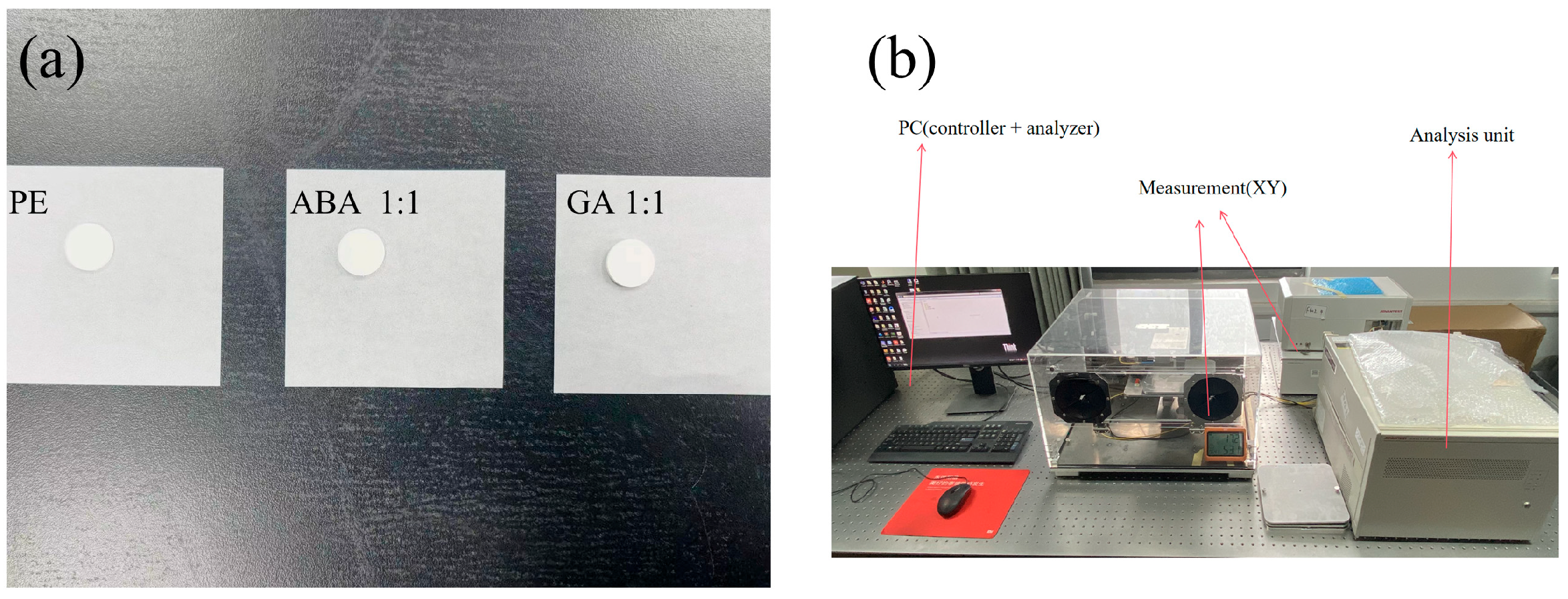


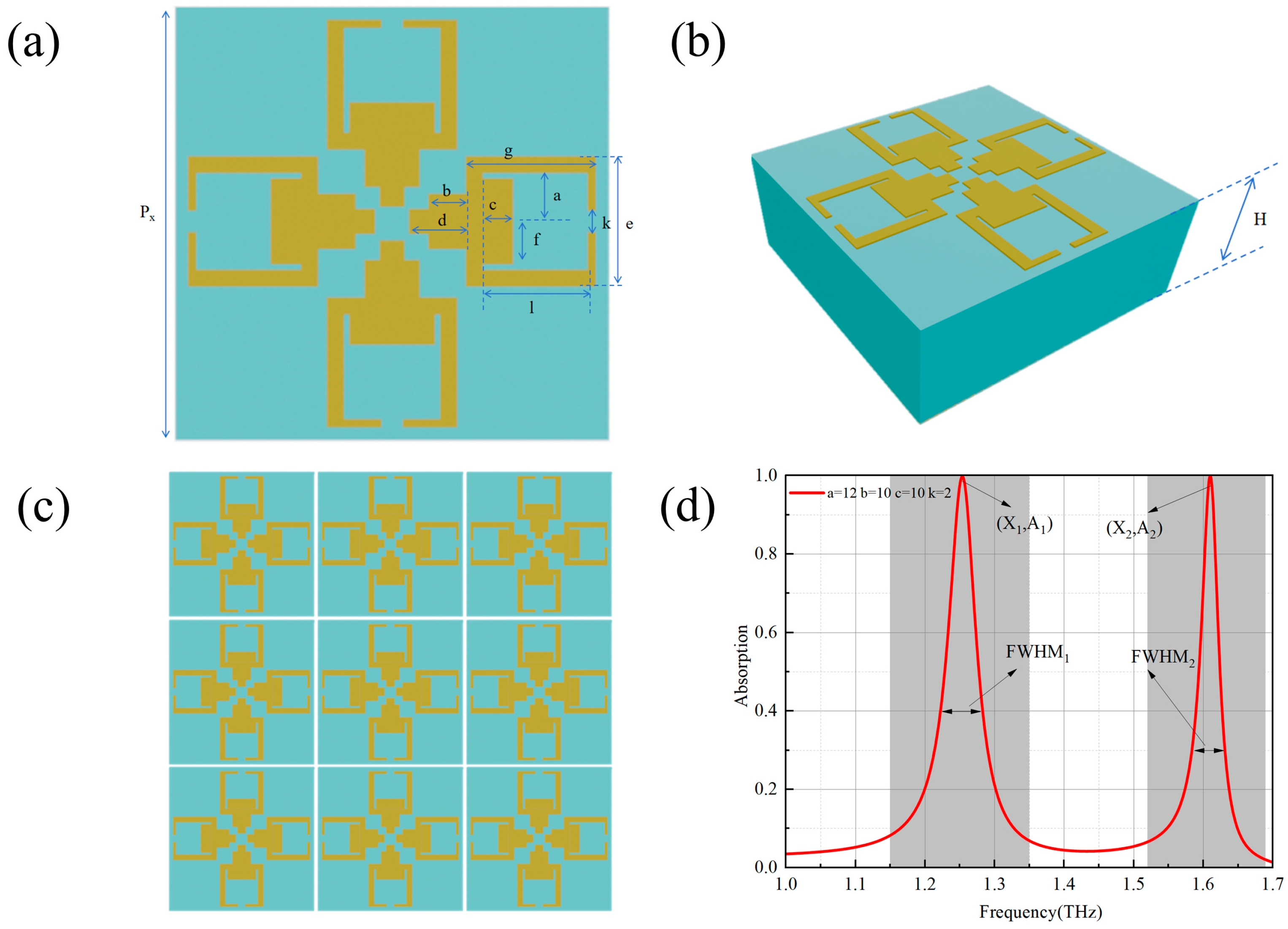
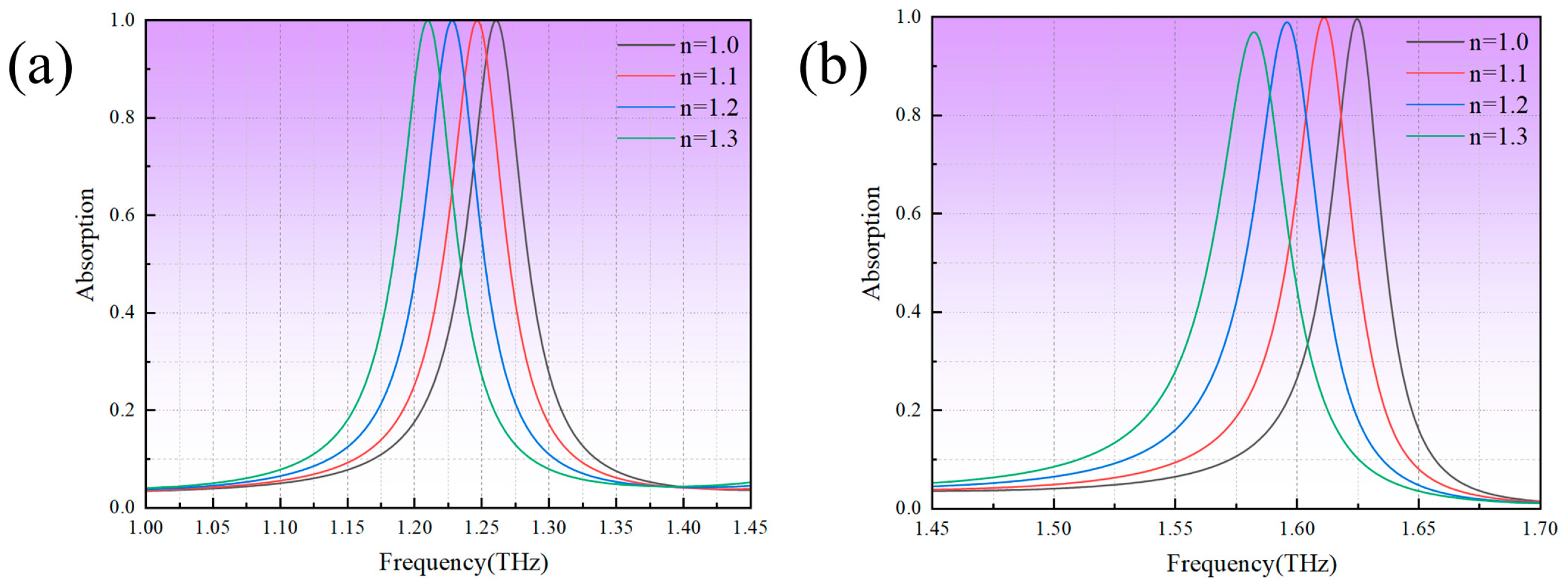


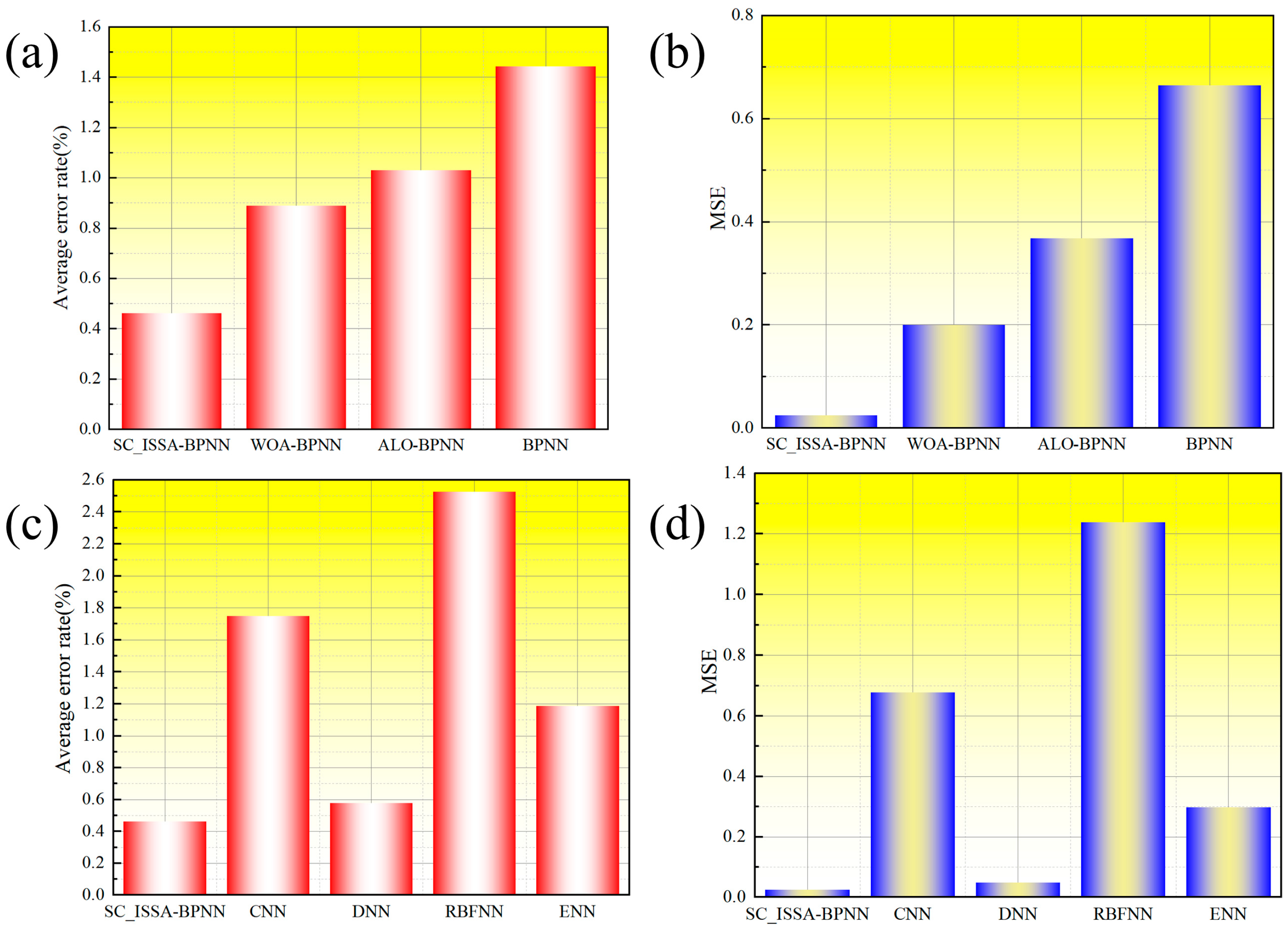

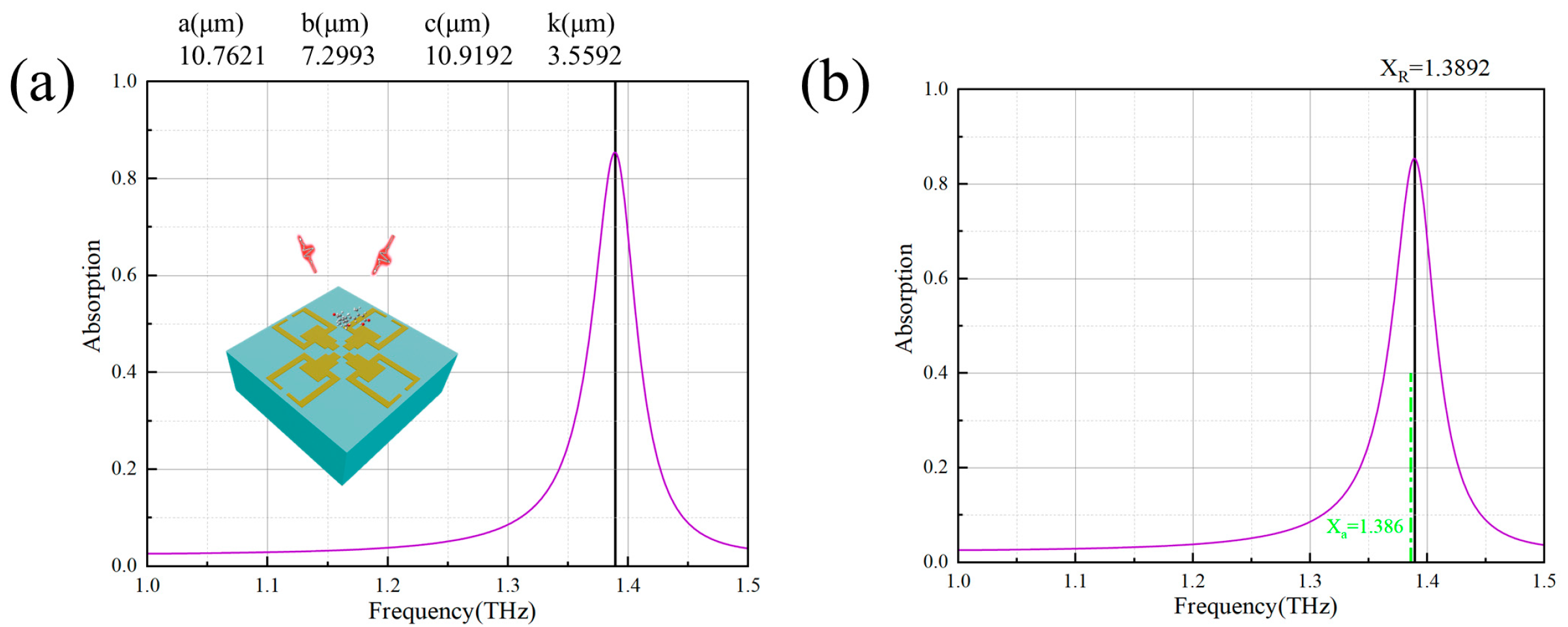



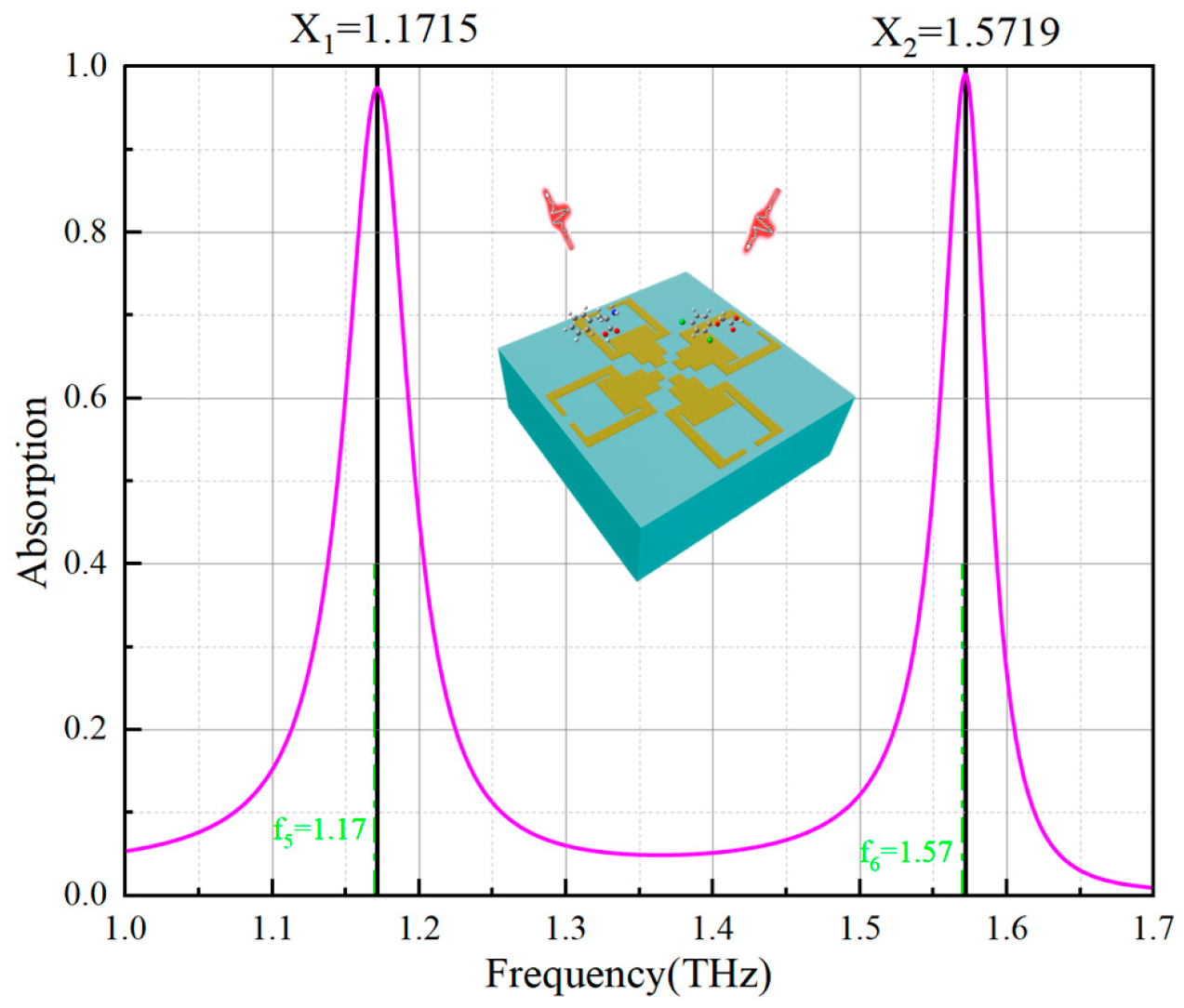
| Geometric Parameter | Min (um) | Max (um) | Step |
|---|---|---|---|
| a | 11.0 | 13.45 | 0.35 |
| b | 6.0 | 10.0 | 0.8 |
| c | 8.0 | 11.0 | 0.5 |
| k | 1.5 | 4.0 | 0.5 |
| Specimen | Experimental (THz) | Theory (THz) | Main Vibration Modes |
|---|---|---|---|
| Abscisic acid | 1.07 | 1.06 | T: C9C10C11C13 |
| 1.386 | 1.489 | O: C6C2C4C3 | |
| 1.706 | 1.722 | T: C3C2C1O14, B: C5C7C9 | |
| Gibberellic acid | 0.955 | 0.88 | T: C11C6C15C16, B: C5C4C6 |
| 1.396 | - | - | |
| 1.613 | 1.61 | T: O1C2C4C5 |
| Ref | Structure | f0 (THz) | S (GHz/RIU) | Minimum Detection Limit |
|---|---|---|---|---|
| [42] | double ring configuration | 0.55 | 124.3 | - |
| [43] | “i” shape | 0.6 | 18 | - |
| [44] | ring configuration | 0.74 | 141 | 0.001 mg/L |
| [45] | “smiley face” structure | 0.851 | 108 | 0.1 ng/mL |
| [46] | hollow structure | 0.331 | 20 | 1 mg/mL |
| [47] | “zigzag” construction | 0.968 | 77 | 6.7 ug/cm2 |
| Category | Fingerprint Peak Characteristic Frequency 1 (THz) | Fingerprint Peak Characteristic Frequency 2 (THz) |
|---|---|---|
| Chlorophyll | f1 = 1.23 | f2 = 1.59 |
| Folpet | f3 = 1.277 | f4 = 1.60 |
Disclaimer/Publisher’s Note: The statements, opinions and data contained in all publications are solely those of the individual author(s) and contributor(s) and not of MDPI and/or the editor(s). MDPI and/or the editor(s) disclaim responsibility for any injury to people or property resulting from any ideas, methods, instructions or products referred to in the content. |
© 2025 by the authors. Licensee MDPI, Basel, Switzerland. This article is an open access article distributed under the terms and conditions of the Creative Commons Attribution (CC BY) license (https://creativecommons.org/licenses/by/4.0/).
Share and Cite
Gao, H.; Liu, Y.; Li, G.; Liu, H.; Shang, Y.; Ma, Z. On-Demand Design of Terahertz Metasurface Sensors for Detecting Plant Endogenous and Exogenous Molecules. Agriculture 2025, 15, 1481. https://doi.org/10.3390/agriculture15141481
Gao H, Liu Y, Li G, Liu H, Shang Y, Ma Z. On-Demand Design of Terahertz Metasurface Sensors for Detecting Plant Endogenous and Exogenous Molecules. Agriculture. 2025; 15(14):1481. https://doi.org/10.3390/agriculture15141481
Chicago/Turabian StyleGao, Hongyan, Yuanye Liu, Gen Li, Haodong Liu, Yuxi Shang, and Zheng Ma. 2025. "On-Demand Design of Terahertz Metasurface Sensors for Detecting Plant Endogenous and Exogenous Molecules" Agriculture 15, no. 14: 1481. https://doi.org/10.3390/agriculture15141481
APA StyleGao, H., Liu, Y., Li, G., Liu, H., Shang, Y., & Ma, Z. (2025). On-Demand Design of Terahertz Metasurface Sensors for Detecting Plant Endogenous and Exogenous Molecules. Agriculture, 15(14), 1481. https://doi.org/10.3390/agriculture15141481






